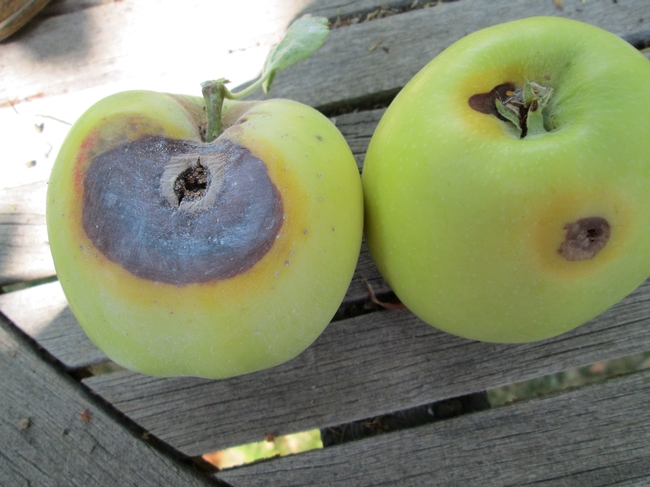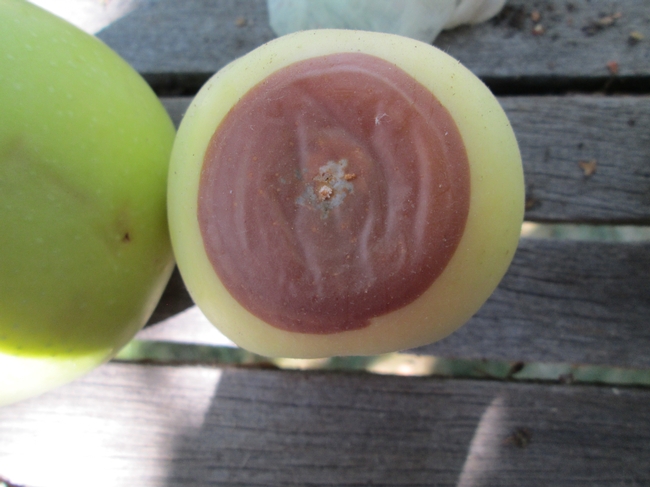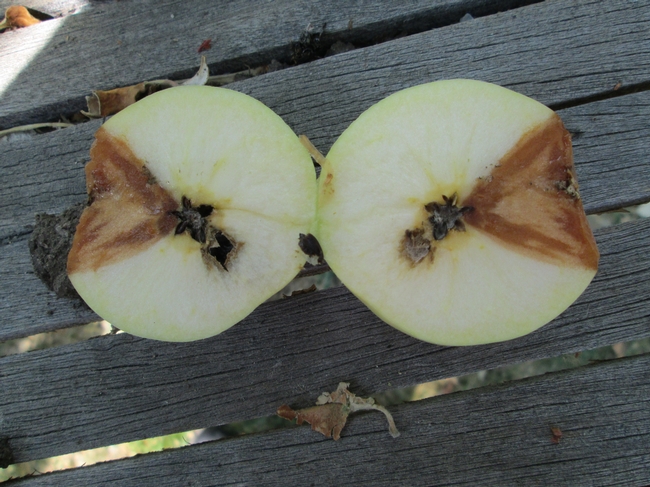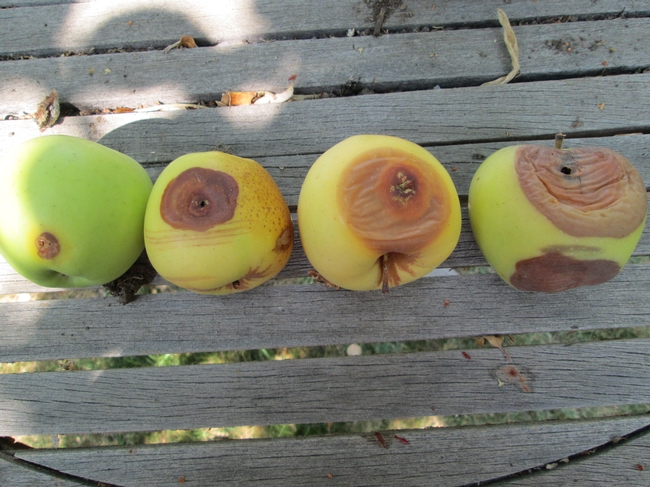I had long ago become resigned to the fact that I cannot grow perfect, blemish-free apples on the two trees that we inherited when we moved to Bishop. There is the challenge of keeping codling moths and aphids under control, thinning prodigious numbers of tiny apples in the spring, and chasing house finches away from the maturing fruit. I have learned to accept peck marks and am happy to remove a codling tunnel or two when canning large volumes, but nothing prepared me for the miseries of an enormous crop of rotted fruit.
Both trees are mature, one being a Gravenstein, the other a Golden Delicious. They ripen about one month apart with the Gravenstein leading the way. This year in spite of the young fruit being thinned and sprayed with Surround, the fruits on both trees were severely affected by codling moths, yet for some reason surface damage on the Gravenstein generally did not go very far into the apple and with a quick flick of the knife it was gone. So when the Golden Delicious started swelling and various small marks and blips appeared on the skin I really did not think too much about them. However, very soon the branches were laden, not with crisp, juicy apples ready to pick, but with brown patches on almost every fruit. Even tiny specks allowed this fungus to enter, and the codling moth damage enabled the fungus to take hold with a vengeance. I thought that I would be able to salvage something to eat from those fruits with minimal damage, but this infection moves fast, frequently entering the fruit through either the calyx or stem and rapidly affecting the core and surrounding tissue and producing the typical fungal odor.
It's likely that a codling moth strike created an opening for some pathogen to enter.

Botryosphaeria species cause "white rot" — a fungus that is extremely common and can affect many woody plants ranging from birch to blackberry and pears to Rhododendron, where it can infect woody tissue and cause cankers. In apples it may infect fruit early in the season without showing, but the rot begins to spread in the warm weather as the fruit matures and shows as circular brown areas.
Brown Rot is caused by a fungus called Monilinia, and it usually affects stone fruits beginning as brown spots which rapidly coalesce to form patches, and then affect the whole fruit. Being primarily a disease of stone fruits, when it does occur on apples (rare), it is usually because the fruit are near infected plums, peaches or nectarines and conditions are optimal for its growth. The sunken brown tissue develops fruiting spores that begin as tiny black spots which then develop whitish heads. Fungicides don't work once the disease has appeared since it enters the fruit through a wound. At the end of the season affected fruits may stay attached to the trees where they shrivel and eventually become mummies, or may drop to the ground, but either way they spread infection through spores being distributed by wind, rain or sprinkler irrigation. Due to our dry climate, brown rot is not a common occurrence in Owens Valley on stone fruits, but it is not unheard of, either.


Photos of fruit infected with a recently recognized fungus, Paecilomyces niveus , look identical to many of the samples from my trees, but the color patterning of the damage looks completely different on other fruits. I hope that it is not this fungus since it produces a toxic substance, patulin which can sicken people, and can survive the high temperatures used in the pasteurizing processing.
A physiological disorder called bitter bit can also cause discoloration, but the lesions are much smaller. It is caused by a calcium deficiency in the developing fruit. (Link to more information.)
Another possibility is a combination of spoilage organisms taking advantage of an opening caused by a codling moth strike. Sometimes it's impossible to tell!
Control of fungal infections is achieved by removing all affected fruit and mummies and disposing of them in some way to prevent the spores from being blown onto other plants. I have buried these in a deep pit, raking up and removing all fallen leaves and pruning out and disposing any twigs that appear to be blighted. Dormant spraying to reduce damage by pests in the following season and thinning fruits early to give plenty of space around each one, monitoring for codling moth and taking appropriate action to control them, should help to control the damage which gives a port of entry for the rot spores. Information on fungicides on backyard apples in California can be found at this page.
I intend to be much more aggressive in taking control measures in future, but since my apple trees are alternate-year bearers, I will have to wait a very long time to know if I have been successful!
For more information about fungal infections of fruit, follow one of these links:
